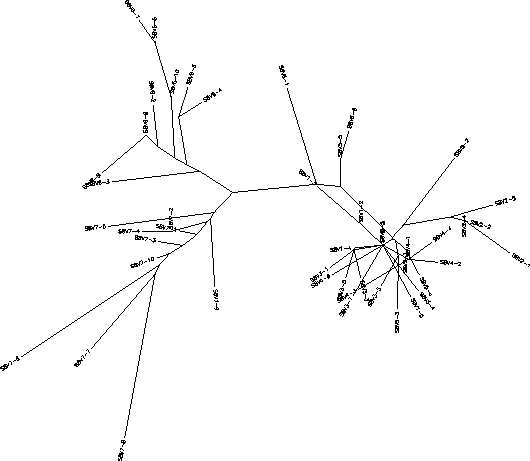Chris Rhodes Week 5: Difference between revisions
No edit summary |
|||
| Line 2: | Line 2: | ||
*To create ClustalW alignments and phylogenetic trees for the chosen subjects(3,7,8,11,12, and 13) each subject's [http://bioquest.org/bedrock/problem_spaces/hiv/nucleotide_sequences.php sequence data]was uploaded onto [http://workbench.sdsc.edu/ Workbench] each as a separate session. | *To create ClustalW alignments and phylogenetic trees for the chosen subjects(3,7,8,11,12, and 13) each subject's [http://bioquest.org/bedrock/problem_spaces/hiv/nucleotide_sequences.php sequence data]was uploaded onto [http://workbench.sdsc.edu/ Workbench] each as a separate session. | ||
[[Image:CHR_Image1_20110928.jpg |Workbench Sessions]] | [[Image:CHR_Image1_20110928.jpg |Workbench Sessions]] | ||
*For each subject's clones a ClustalW alignment was run using default parameters to generate both the rooted and unrooted phylogenetic trees. | *For each subject's clones a ClustalW alignment was run using default parameters to generate both the rooted and unrooted phylogenetic trees. The S value was also calculated from the alignment. | ||
*For each subject's ClustalW alignment a Clustdist matrix was created to find the Minimum and Maximum Divergence. | *For each subject's ClustalW alignment a Clustdist matrix was created to find the Minimum and Maximum Divergence. | ||
==Subject 3== | ==Subject 3== | ||
'''Unrooted Tree''' | '''Unrooted Tree''' | ||
Revision as of 19:08, 3 October 2011
Methods
- To create ClustalW alignments and phylogenetic trees for the chosen subjects(3,7,8,11,12, and 13) each subject's sequence datawas uploaded onto Workbench each as a separate session.
- For each subject's clones a ClustalW alignment was run using default parameters to generate both the rooted and unrooted phylogenetic trees. The S value was also calculated from the alignment.
- For each subject's ClustalW alignment a Clustdist matrix was created to find the Minimum and Maximum Divergence.
Subject 3
Based on both the rooted and unrooted trees you can see that Subject 3 had very high diversity and divergence. The rooted tree shows a large vertical distance between its two ends and a large amount of branching with no branch being prominent. The clones seem to cluster together based on their visit number to create the various branches and show little similarity with clones outside of their own visit. The long branches between the clones show an amount of intravisit diversity as well. The only exceptions to this pattern are some of the clones of visit 4 who share greater similarities to visit 1 or 3 clones rather than with other visit 4 clones. However, this overall pattern is indicative of an immune response in which there is high selection happening against a lack of change in the amino acid sequence which results in large divergence between every visit.
Subject 7
Based on the rooted tree Subject 7 has a very large amount of genetic diversity between its clones and its and its visits. The minimum and maximum divergences were found to be and respectively. Like Subject 3, Subject 7's clones show a good amount of clustering based on visit number however unlike Subject 3, Subject 7 shows distinct intravisits clusters meaning that there is more than 1 cluster per visit. Subsequently Subject 7 has a significant amount of intravisit diversity especially within visits 2 and 4. Visits 3 and 5 conversely. Subject 7 also shows a horizontally prominent branch which contains clones from visits 1, 2, and 4. Visit 3 represents a large divergence from visits 1 and 2 but does not have any subsequent visit clones on its branch indicating that the visit 3 strains may developed a mutation that increased replication . A best fit theory would explain the initial diversity of visits 1 and 2 along with the apparent decline as the virus progresses. This theory of a best fit virus is also supported by the large diversity and sudden disappearance of the visit 3 strains.
Subject 8
Based on the rooted and unrooted trees Subject 8 has an overall large amount of diversity and divergence but the rates of diversity and divergence change overtime. There is little intravisit clustering for visits 1-5, however visits 6 and 7 cluster together based on their visits forming two horizontally prominent branches. From visits 1-5 there seemed to be little diversity or divergence between the different clones and visits, however visits 6 and 7 represent a very large jump in diversity and divergence from the visits 1-5 clones. Visit 7 clones also have long branches showing an amount of intravisit diversity. Based on this it can be hypothesized that the immune system of Subject 8 was originally selecting against significant or functional change and then suddenly between visits 5 and 6 began selecting for change. This might be explained by an immune system that was unable to detect the protein coats of anything functionally similar to visits 1-5, but which between visits 5 and 6 developed a way of recognizing and destroying proteins coats functional similar to visits 1-5. In this way, the immune system shifts from selecting against change to selecting for change and explains how Subject 8's tree may have developed.
Subject 11
Subject 12
Subject 13
References
Links
- Chris Rhodes User Page
- Week 2 Journal
- Week 3 Journal
- Week 4 Journal
- Week 5 Journal
- Week 6 Journal
- Week 7 Journal
- Week 8 Journal
- Week 9 Journal
- Week 10 Journal
- Week 11 Journal
- Week 12 Journal
- Week 13 Journal
- Week 14 Journal
- Home Page
- Week 5 Assignment Page
- Week 6 Assignment Page
- Week 7 Assignment Page
- Week 8 Assignment Page
- Week 9 Assignment Page
- Week 10 Assignment Page
- Week 11 Assignment Page
- Week 12 Assignment Page
- Week 13 Assignment Page
- Week 14 Assignment Page












